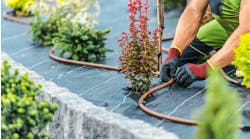Minnetonka, Minn. — Environmental organization Live Green, Live Smart has retrofitted a 1948 house here into one of the greenest houses in the country.
The group has transformed an ordinary post-War rambler in a suburban neighborhood into a “century house” designed to be energy efficient, environmentally healthy, respectful of the natural environment, and comfortable for family life.
Live Green, Live Smart said that “The Sustainable House” was the nation's first home remodel to achieve LEED Platinum certification from the U.S. Green Building Council.
Because this is a demonstration project, the House incorporates many redundant energy supplies.
Solar panels provide both electricity for the home and energy to heat water. A nontoxic heat transfer liquid is pumped through the circulation loop first to the roof, where it is run through the thermal collectors. The heated liquid travels to a Rheem Solaraide water heater where the heat transfer fluid is dispersed into a fluid jacket that surrounds a tank. This system is used as a replacement for a traditional water heater. On days when more hot water is needed, a backup system makes up the difference. Controls were supplied by Caleffi Solar.
The Honda/Climate Energy Freewatt combined heat and power system uses natural gas to co-generate electricity and forced air heat. The CHP unit produces 1.2kW of electricity and 12,000 Btuh of heat simultaneously. The electricity is used to power lights, low-voltage systems and appliances. The heat is put into a high-efficiency, low- and constant-flow furnace. Unspent gas also goes into a catalytic converter, which produces more heat and also reduces emissions to zero.
Underneath the House's front walkway are four 135-ft. deep geothermal wells, which circulate a glycol solution to the WaterFurnace geothermal heat pump. The unit was installed by geothermal and radiant contractor UMR Geothermal, Maple Plain, Minn.
Radiant in-floor heating helps save on energy costs by keeping feet warm and keeping thermostats turned down. STEP Warmfloor flexible electric heating mats were used in the mudroom and the bathrooms under ceramic flooring. The heated floors also have the benefit of quickly drying the floors and inhibiting mold growth.
Each bathroom in The House is equipped with the Aquia Dual Flush Toilet made by Toto. The toilets conserve water with a 1.6-GPF/0.9-GPF system with a push button style flush option that allows the user to control the amount of flushing. The toilets are flushed with recycled graywater that comes from a packaged graywater recycling system supplied by Brac Systems, Montreal, Quebec, Canada, that takes water already used in showers and sinks, filters it, and reuses it in the toilets.
Bathrooms are equipped with Toto's water-saving on-off faucets that use batteries that are recharged by water flow through the supply valves. Other kitchen and bathroom faucets and fittings were supplied by Grohe.
Domestic water is filtered through a water softener supplied by Culligan and drinking and cooking water in the kitchen goes through a Culligan reverse osmosis unit. The backwash from the RO unit is fed through the Brac graywater package for toilet flushing.
The home also features fire sprinklers supplied by Viking Automatic Sprinkler.
The Sustainable House is outfitted with EnergyStar products wherever possible, including the refrigerator, clothes washer and dishwasher. For appliances with no EnergyStar guidelines, such as the stove/oven, Live Green, Live Smart is choosing the most efficient models available for the application.
The house is a demonstration laboratory occupied by an ordinary American family, although the structure will be extraordinarily monitored for the performance of systems and materials for the next three years. While all the technology is currently available on the retail market, some of it is being used for the first time in a residential application in the upper Midwest region of the U.S.

